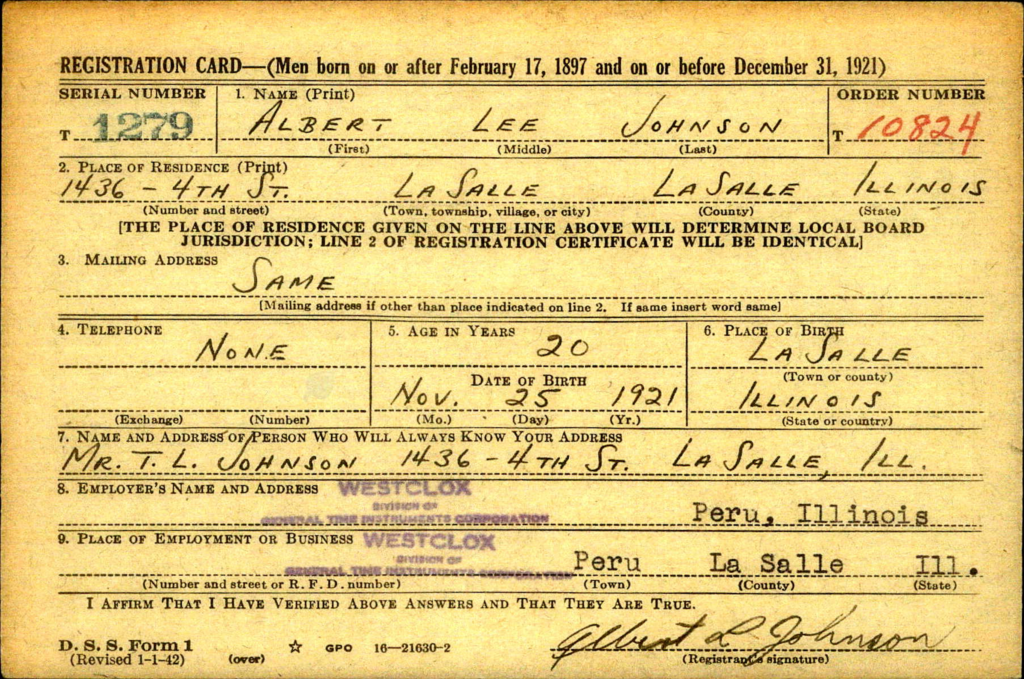Military Service
In the summer of 1943, 21-year-old Albert Lee Johnson joined the U.S. Army to serve his country in World War II. He trained at Camp Reynolds near Greenville, Pennsylvania and in May 1944 deployed overseas as a medical aidman in the 18th Infantry Regiment of the 1st Infantry Division. A month later he parachuted into Europe as part of the D-Day invasion. In the ensuing months, PVT Johnson’s resolve was unyielding as he aided his unit across the war-torn landscapes of France and Belgium.
Amidst the chaos of one of his unit’s battles in Germany on 15 September 1944, PVT Johnson crawled as he did many times before through intense artillery, mortar, machine gun and small arms fire. On that day, he maneuvered through this deadly terrain to rescue a fellow soldier lying perilously close to an enemy pillbox, ensuring his safe evacuation. This act of heroism earned him the prestigious Distinguished Service Medal, a testament to his courage and selflessness.
In the weeks that followed, he continued his noble work under the harshest of conditions, treating the wounded amidst the unrelenting fury of shelling and gunfire. “The month of October opened with the 18th Infantry Regiment preparing to leave its defensive position in the damp forest South of Aachen, Germany.” The plan was to seize Valautenheide and Crucifix Hill and join up with the American XIX Corps. “the attack was set for the early morning of 8 October 1944.” Troops began moving towards the target near midnight on the seventh. By the next morning the 2nd Battalion gained its objective. The 1st Battalion then moved through their lines and by later that afternoon, the unit had secured Crucifix Hill. During the battle, PVT Johnson was once again crawling through enemy fire to rescue his fellow soldiers and bring them to safety. However, as he was carrying a wounded soldier back to their line, he was killed in action.
Early Life
Albert Lee Johnson was born in LaSalle, Illinois, on 25 November 1921, to Turley Lee and Hattie Bell (Lanier) Johnson. The couple had married six years before Albert’s birth, in Jacksonville in Morgan county, Illinois, and already had two daughters: Helen and Clara. The couple also had a daughter Leiah who was stillborn. After the birth of Helen, their first child, Turley and Hattie relocated to the LaSalle-Peru area of Illinois. There Turley initially worked as a laborer first for Joseph Trompeter and later for the Zinc Works. Eventually he took a job as a switchman for the railroad. In the summer of 1925 Turley and Hattie welcomed another son Edward Patrick Johnson.
During the 1930s the country was suffering from the Great Depression and many families struggled to make ends meet. This may be why the children in the Johnson family like many others at that time chose to leave school and work. So at age 16, Helen was working as a truerer at Westclox—a local clock factory. And as Helen and Clara reached adulthood, they both married.
By 1940 Albert’s parents had purchased a home at 1436 Fourth street in LaSalle. That year at age 18, Albert was working for the Civilian Conservation Corps. The Corps or CCC was a New-Deal-era program established by President Roosevelt to offer employment to single, young men. Two years later in 1942, he was working at Westclox where his sister was previously employed. That year, Albert also registered for the draft on 16 February 1942. Then 20 years old, he stood 5 foot 10 inches tall and weighed 155 pounds with blue eyes and brown hair.

By summer, Albert was married to Ruth Mordell. While both Albert and Ruth were from LaSalle, their marriage took place in Canton, in Lewis county, Missouri. However, they both appeared to settle back in their hometown soon after getting married. And a year later, Albert was called to service; he enlisted on 8 July 1943. After serving for over a year, he was killed in action on 8 October 1944, in Germany while rescuing a wounded soldier. He was buried in Europe and later his remains were returned to the U.S. for burial on 9 January 1948, in Camp Butler National Cemetery in Springfield, Ill.
For his service and bravery, PVT Albert Lee Johnson was posthumously awarded the Distinguished Service Cross in addition to the following medals: American Campaign Medal, WW2 Victory Medal, European-African-Middle Eastern Campaign Medal, and the Army Good Conduct Medal. His journey from a young man in Illinois to a valiant soldier on the battlefields of Europe is a poignant reminder of the sacrifices made by countless individuals during one of history’s darkest times.
Several years after his death, Albert’s wife remarried. His parents remained in LaSalle. His father passed away in 1961 and his mother in 1971. His brother Edward Johnson also served in WWII in the U.S. Navy.
Family Background
Albert’s parents were not originally from Illinois. His father, Turley, was born in 1894 in Knoxville, Tennessee, to Patrick and Malinda (Reed) Johnson. His mother, Hattie, was born in 1893 in Atlanta in Cowley county in Kansas, to William and Eliza Belle (Wolf) Lanier. As Albert’s grandparents passed away either before he was born or while he was young, he most likely did not know them well or not at all.
Albert’s ancestral lineage includes examples of men who like him faced danger with bravery and fortitude. His 2X great-grandfather, Major Henry Hugh, fought in the Revolutionary War as a member of the King’s Mountain Men under Capt. Isaac Bledsoe. After the war Henry followed John Sevier and other colonists into land that would later become Tennessee and organized the area into the state of Franklin from lands then considered in North Carolina. Several months later, “on May 31, 1785, Major Hugh Henry, Sevier, and other representatives of the self-declared state met with Cherokee Chiefs to negotiate the ‘Treaty of Dumplin Creek,’ which promised to redefine and extend the Cherokee boundary line.” This would be the only treaty to be negotiated by the short-lived state. Soon after the United States which did not recognize the state of Franklin’s authority deemed the treaty illegal. Once Franklin was dissolved and the state of Tennessee formed, John Sevier became its first governor.
Major Hugh Henry and Albert’s Johnson line settled in Sevier county in Tennessee. Albert’s grandfather, Patrick “Pad” Johnson does not appear to have fought in a formal war. Yet stories have been passed down of his bravery in the face of a vigilante organization which terrorized the county in the 1890s. On at least one occasion, the group, known as the “White-caps” showed up at a home on Pad’s property where the Breeden family lived. Seeing them arrive, Jesse Breeden ran off to tell Pad the White-caps were attacking the Breeden sisters. Pad didn’t hesitate in grabbing his revolver and making his way to confront the group. The White-caps upon seeing Pad shot at him. Pad didn’t stop coming as “was not the man to leave dust in the road behind him at the first onslaught of a White-cap battle.” Pad shot back as fast as he could. The White-caps fired once more then fled.

You can also access this story at the following sites:
Fold3 Memorial: https://www.fold3.com/memorial/664249079/johnson-albert-lee-pvt/stories
Sources:
- 1920 U.S. Census, Ancestry.
- 1930 U.S. Census, Ancestry.
- 1940 U.S. Census, Ancestry.
- “Illinois, U.S., County Marriage Records, 1800-1940,” Johnson to Lanier, Ancestry.
- “Certificate of Stillbirth,” State of Illinois, Morgan County, Leiah Bill Johnson, 1916.
- “U.S., Social Security Applications and Claims Index, 1936-2007,” Turley Lee Johnson, Ancestry.
- “U.S., Social Security Applications and Claims Index, 1936-2007,” Hattie Bell Johnson, Ancestry.
- “U.S., Social Security Applications and Claims Index, 1936-2007,” Clara Johnson Lewis, Ancestry.
- “U.S., Social Security Applications and Claims Index, 1936-2007,” Ruth Rebecca Mordell, Ancestry.
- Obituary for Edward Johnson, NewsTribune (LaSalle, IL), 7 July 2005, GenealogyBank.
- “Illinois, Cook County Deaths, 1871-1998,”, Albert Lee Lewis, 1992, FamilySearch.
- “Into the Woods: The First Year of the Civilian Conservation Corps,” National Archives.
- “Missouri, U.S., Marriage Records, 1805-2002,” Albert Lee Johnson and Ruth Mordell, Ancestry.
- https://www.findagrave.com/memorial/61556519/helen-mikus
- Daughters of the American Revolution, Ancestor #A053743, Hugh Henry.
- E.W. Crozier, The White-Caps: A History of the Organization in Sevier County. Knoxville, TN, 1899: Bean, Warters & Gaut, pp/ 188–9 Internet Archive.
- Kathrine Keogh White, Kings Mountain Men, p. 104 Dayton, Virginia, 1924: Joseph K. Reubush Company.
- “U.S., World War II Draft Cards Young Men, 1940-1947,” Edward Patrick Johnson, Ancestry.
- “U.S., World War II Draft Cards Young Men, 1940-1947,” Albert Lee Johnson, Ancestry.
- “U.S., National Cemetery Interment Control Forms, 1928-1962, “ Albert L. Johnson, Ancestry.
- Unit History, 18th Infantry Regiment, for Period 1-30 September 1944 and 1-31 October 1944. U.S. Army.
- Benjamin C. Nance, A Survey of Sites Related to The American Revolution And War Of 1812 In Tennessee, 2004, Tennessee Division of Archaeology.
- “Cherokee in Kentucky,” Southern Cherokee Nation Kentucky Website.
- https://achh.army.mil/regiment/dsc-wwii-wwii-il
- https://www.findagrave.com/memorial/2555735/albert-l-johnson